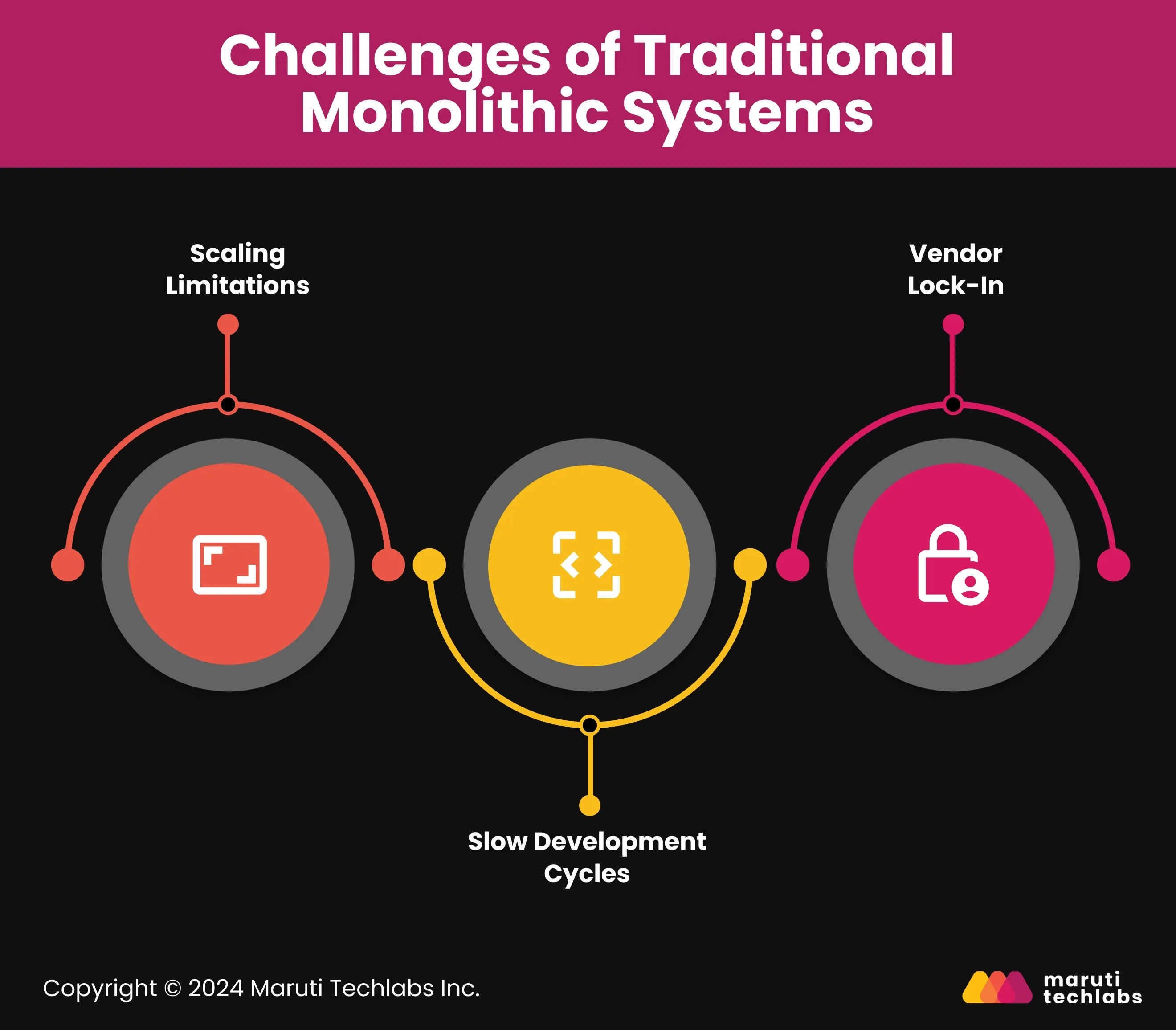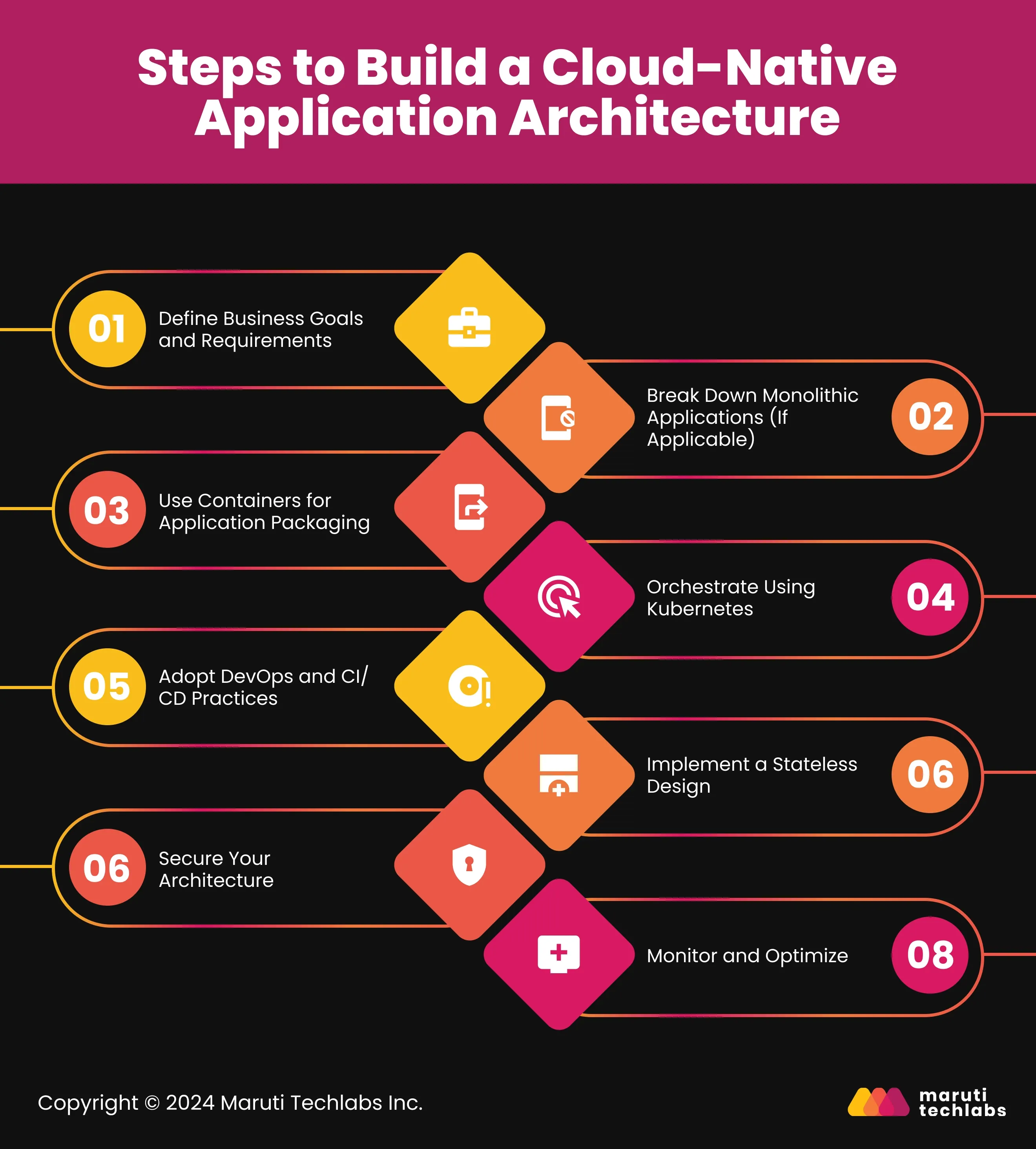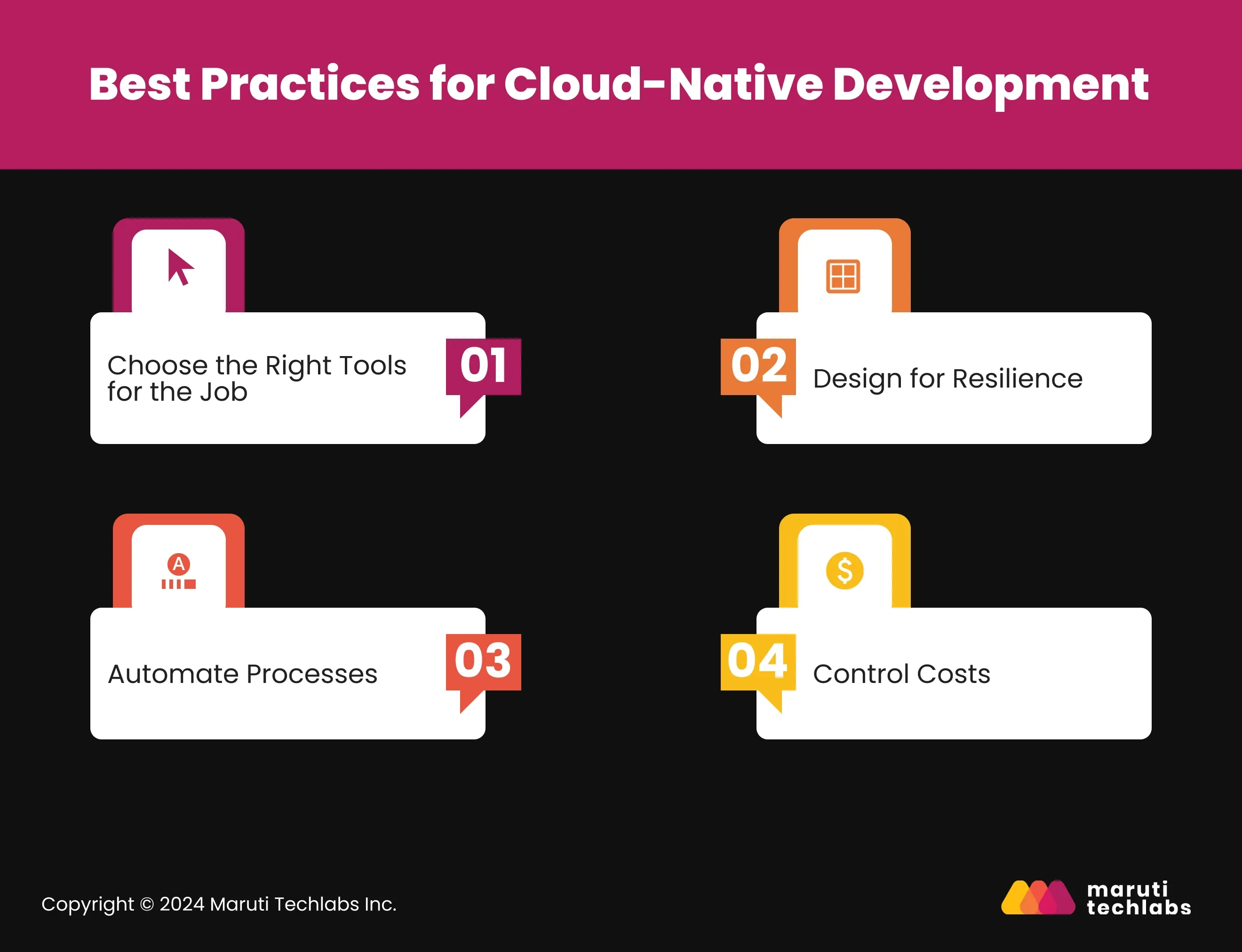

How to Build a Scalable and Resilient Cloud-Native App Architecture






For many businesses, traditional systems simply can’t keep up with these spikes in demand, resulting in lost opportunities at the most critical times. Cloud-native architecture changes the game. It maintains the website's speed, stability, and dependability by dynamically scaling to accommodate periods of high traffic and optimizing resources during slower periods.
In this blog, we’ll break down the steps to building a cloud-native architecture that empowers your business to easily handle the unpredictable. From managing rapid traffic surges to deploying updates faster, you’ll discover how this approach transforms challenges into opportunities, making your applications a cornerstone of business success.
Building software today means creating adaptable systems that scale, evolve, and simplify operations. Cloud-native applications deliver unmatched scalability and flexibility to meet these needs.
Cloud-native applications are built to maximize the power of cloud computing. Instead of relying on rigid, traditional monoliths, they use microservices—small, independent components that perform specific tasks. These microservices work together seamlessly, allowing developers to develop, scale, and update individual features without disrupting the entire system. This modular approach boosts agility and ensures your applications are always ready to meet evolving business demands.
Let’s explore how cloud-native applications function differently from traditional systems.
1. Microservices Architecture
Applications are divided into independent modules (microservices), such as authentication, payment processing, or search functionality. Each module can be developed and updated separately.
Example: In a streaming platform, the recommendation engine works as a microservice, allowing developers to fine-tune algorithms without touching video playback or user account services.
2. Containerization
Developers package microservices into containers using tools like Docker, ensuring each service includes everything it needs to run consistently across different environments.
Example: A healthcare platform can deploy its patient records service consistently across private hospital servers and public cloud providers without reconfiguring code.
3. Orchestration Tools
Platforms like Kubernetes automatically manage containers, scaling them up or down based on demand. They ensure services remain operational by redistributing workloads if a container fails.
Example: An e-commerce platform uses Kubernetes to handle a Black Friday surge, ensuring inventory services scale up during peak hours and down afterward to save costs.
4. API Communication
Microservices use APIs to communicate, keeping services loosely connected and independent.
Example: A logistics app allows the tracking microservice to pull live GPS data from a fleet management service without integrating tightly, enabling easy updates or replacements.
Cloud-native applications aren’t just technical upgrades but solutions to real-world challenges businesses face daily. Here’s how:
1. Addressing Real Business Challenges
Businesses today face unpredictable demands, rising costs, and the need for faster innovation. Cloud-native systems offer flexibility and scalability to address these challenges. For instance, during a product launch, a cloud-native application can scale its services automatically to handle a 5x increase in user traffic without compromising performance. Similarly, CI/CD pipelines allow updates to be deployed in minutes instead of days, ensuring businesses remain competitive. By leveraging dynamic resource allocation, businesses optimize costs by only paying for what they use, significantly reducing operational overhead.
2. Delivering Measurable Business Impact
The impact of cloud-native systems extends far beyond technical efficiency. Real-world applications of cloud-native principles demonstrate their transformative potential:
3. Ensuring Resilience and Reliability
Reliability is non-negotiable in any business, and cloud-native systems excel in this area. Built for resilience, they ensure that failures in one component don’t affect the entire system.
For instance, when a payment service in a ride-hailing app briefly goes offline, orchestration tools like Kubernetes step in to reallocate resources and restore functionality. The rest of the application remains fully operational, ensuring seamless service for users. Such fail-safe designs minimize disruptions and safeguard business continuity.
Traditional architectures struggle to meet modern needs. Here’s why they often fail:

1. Scaling Limitations
Traditional monolithic architectures face significant limitations that make them ill-suited for modern business needs. One major challenge is scalability. Monolithic systems require scaling the entire application rather than individual components, leading to resource wastage and increased costs.
For instance, a retail app with a single database architecture may struggle to handle traffic surges during sales events, resulting in missed opportunities and frustrated customers.
2. Slow Development Cycles
Another issue is the slow pace of development and deployment. Any updates or changes to a monolithic system often require redeploying the entire application, causing unnecessary downtime. This delays the rollout of new features and reduces agility.
For example, a legacy HR platform might need a complete system refresh just to implement a payroll update, hindering the organization’s ability to respond quickly to market demands.
3. Vendor Lock-In
Finally, monolithic systems often lead to vendor lock-in. Businesses relying on tightly integrated legacy systems may find it difficult to switch to more efficient technologies. For example, a company tied to an outdated database provider may struggle to adopt innovative solutions, limiting its ability to grow and compete in an evolving market.
Building a cloud-native architecture requires strategic planning and the right tools. Let’s explore the actionable steps for designing scalable, efficient, and future-ready systems.
Building a cloud-native application architecture involves more than adopting modern tools.

Following these steps, you can create a scalable, secure, and efficient foundation for your cloud-native app development journey.
The first step in cloud-native app development is setting clear objectives. Determine what your business aims to achieve—improving scalability, reducing costs, or accelerating feature deployment. Align the architecture with specific outcomes that drive these goals.
For example, a growing e-commerce platform might prioritize seamless scaling to handle fluctuating traffic during sales events. Defining these goals ensures the architecture delivers measurable value.
Refactoring monolithic applications is a critical step for businesses transitioning from traditional systems. Break down large, tightly coupled systems into modular microservices. Start by prioritizing high-impact functions like user authentication or payment processing.
This approach allows teams to develop, deploy, and scale individual services independently, reducing downtime and enhancing agility. Over time, transitioning the entire system ensures flexibility and better performance.
Containers are essential for cloud-native app development. They package applications and dependencies together, ensuring consistent performance across environments. Tools like Docker make it easy to create portable and isolated environments for each service.
For instance, a healthcare app can run patient data services consistently across private hospital servers and public cloud providers, avoiding compatibility issues.
At scale, the management of containers is increasingly inefficient. The automation of the deployment and scaling of applications, as well as resource utilization, makes complexity more manageable with Kubernetes. By using Amazon EKS or Red Hat OpenShift, managed services can reduce operational overhead, and the business can focus on other core activities.
For instance, a streaming platform scaled its video delivery service to support 1 million live viewers during high-traffic events and had smooth performance provided by dynamic scaling in Kubernetes. Kubernetes ensures systems stay reliable and perform efficiently under unpredictable demand by automating resource allocation and recovery.
CI/CD and DevOps are vital in maintaining rapid and reliable development. Continuous integration involves automated code testing, while continuous delivery ensures updates occur without disruption. These practices reduce the chances of misunderstandings and enhance the release speed. For instance, a logistics company can implement route optimization improvements weekly without disrupting operations.
Stateless applications offer several benefits, including scalability and fault tolerance. In this model, microservices do not maintain session data across different services; an external system manages the state. It can use databases or distributed caches like Redis and DynamoDB to ensure system consistency and fault tolerance. For instance, a ride-hailing application can maintain all its ongoing bookings even if the service is restarted because session data is stored in an external system.
Security is integral to cloud-native app development. Apply Zero-Trust principles to validate every interaction within and outside the system. Secure APIs using robust authentication mechanisms like OAuth 2.0 and encrypt data in transit and at rest with TLS and KMS. A retail app processing customer payment details can safeguard sensitive data while complying with industry regulations.
Monitoring helps the architecture work optimally in real-time conditions. It involves daily monitoring of system health and using Prometheus and Grafana to find the root cause of slowdowns. Specialized tools include Application Performance Monitoring (APM), which provides additional application-level information to optimize application performance in real-time. For instance, an IoT platform can determine how resources are used so that services can be scaled up and the cost of operations can be cut down.
By following these steps, businesses can establish a cloud-native architecture tailored to their goals. Next, we’ll explore the core features that make cloud-native applications powerful, from their modular design to their ability to adapt seamlessly to changing demands.
Cloud-native app development is all about building efficient, adaptable, and ready-for-growth applications. The core features that make cloud-native apps so effective are centered around flexibility, independence, and optimized performance.
Cloud-native applications use a microservices architecture, where developers divide the application into smaller service components, each responsible for a single functionality. This approach simplifies development because teams can independently work on and deploy individual services. It allows businesses to enhance functionality and address specific application issues simultaneously.
For example, in a retail platform, microservices can manage inventory details, checkouts, and customer account management separately, making it easier to scale each process individually.
A stateless design ensures that cloud-native apps are highly scalable and fault-tolerant. A stateless design ensures that cloud-native apps are highly scalable and fault-tolerant. Each can work independently to eliminate focal points when session data is not stored on an application server. This approach depends on external storage devices such as Redis or DynamoDB, making services more flexible.
For example, a ride-sharing app can handle multiple user requests simultaneously without worrying about session storage because the data is managed by an external service, ensuring quicker response times even with high traffic.
The foundation of cloud-native apps is APIs. They facilitate easy integration of third-party services and smooth communication between microservices. Businesses may increase functionality and maintain agility with this open, adaptable communication system without completely redesigning it.
A banking platform, for example, can use APIs to combine real-time payment processing with outside financial institutions, enabling smooth transactions without sacrificing security.
Developers can package apps into standardized, lightweight components thanks to containerization. By eliminating compatibility problems, tools such as Docker guarantee that services operate without a hitch in various contexts. These containers are orchestrated by Kubernetes, which also automatically manages monitoring, recovery, and scalability.
This combination guarantees that cloud-native apps can adapt to user needs without requiring human involvement. To ensure seamless playing even during peak hours, a media streaming service, for example, can automatically adjust the number of active containers based on the number of customers watching live events.
These core features enable cloud-native applications to meet the demands of modern businesses. Now, let’s explore the best practices for cloud-native development to ensure your applications are secure, efficient, and ready for long-term growth.
Cloud-native app development helps businesses scale, innovate, and stay resilient. By following the right practices, you can build systems that are efficient and prepared for growth.

Selecting the right tools is more important when developing cloud-native applications. For instance, Node.js is more appropriate for small applications that require a short development time, while Spring Boot is more suited to microservice development. Choosing the right tool ensures more effective development and better properties to meet the company’s requirements.
Failure is a critical consideration for DevOps, and cloud-native applications must be designed with this in mind. Implementing redundancy and fallback solutions guarantees operations will continue even if one service fails. For instance, a web host directing clients to an online store can have a backup plan to reroute traffic to other servers if the primary server fails, guaranteeing that customers can still buy.
Automation accelerates cloud-native app development. Tools like Terraform and AWS CloudFormation can automate infrastructure provisioning, guaranteeing consistency and lowering errors. Automated testing and deployment speed up and improve the reliability of your development process. For instance, automating your deployment pipeline can allow a financial services firm to release new features faster, improving customer satisfaction and minimizing downtime.
Automation accelerates the development of cloud-native applications. Terraform and AWS CloudFormation enable you to provision your infrastructure in a highly controlled manner, increasing resilience and lowering error rates. Your development cycle is accelerated and enhanced when the outcomes include automated testing and deployment, resulting in considerably superior end products.
Following a discussion of recommended practices for cloud-native development, we'll emphasize the critical need to make your apps secure and effective while also ensuring they can resist failures and attacks.
Cloud-native applications need robust security and resilience strategies to handle potential threats and unexpected failures. These principles ensure applications perform well and remain protected and available under challenging conditions.
Trust should never be assumed in cloud-native environments. A zero-trust security model requires verifying every user, device, and service at all access points. Implementing least-privilege access ensures that users and services have only the minimum necessary permissions, reducing the risk of breaches.
For instance, in an e-commerce platform, admins may have full access, while a customer support rep would only access customer service tools. This minimizes exposure to sensitive data and keeps your system secure.
While zero-trust security addresses identity and access management, defense-in-depth goes further by layering multiple security measures. This includes securing the network, using encryption for data at rest and in transit, and applying stringent controls at the application level.
For example, a banking app could use firewalls to block unauthorized access, TLS encryption to secure data, and end-to-end encryption to protect sensitive transactions. This comprehensive approach ensures that, even if one layer fails, others provide backup protection.
No cloud-native app is complete without being built for failure. Load balancers distribute traffic evenly across servers, while failover strategies ensure backup systems take over if a primary service fails.
For example, a ride-hailing app could use cloud load balancing to ensure customers can book rides, even if one server goes down. Additionally, disaster recovery plans help businesses restore systems quickly after major outages or data loss, ensuring business continuity.
Adapting these strategies can protect such businesses’ cloud-native applications from various risks. Next, we will discuss the case and describe the transition of enterprises to a cloud-native architecture in more detail, using an e-commerce platform as an example.
Switching an e-commerce platform to a cloud-native architecture may increase its growth rate, making it more efficient and reliable. With these changes, customers require solutions that can scale and meet the needs of businesses while maintaining their functionality.
Here is a fictionalized representation of how to architect the move from monolithic architecture to a cloud-native architecture.
First, the e-commerce platform’s centralized, large monolith order management system is decomposed into more fine-grained and decentralized services. Every functionality, such as order tracking, payments, inventory, and more, transforms into mini-servers known as microservices. This makes the management and scalability of the individual services easier.
For instance, during Black Friday, the payment service can increase demand in addition to the inventory system to reduce the time taken during peak hours, hence enhancing customers’ satisfaction.
These microservices are containerized with Docker, ensuring they operate in the same environment as during development. This process simplifies deployment and reduces compatibility issues across development, staging, and production environments.
For example, the checkout service must be containerized to function seamlessly in both the testing environment and the cloud, which reduces the likelihood of deployment errors and accelerates the release cycle.
Next, Kubernetes is employed to manage and scale the containers automatically. It adjusts the number of containers running based on real-time user traffic. During peak times, such as flash sales or product launches, Kubernetes can scale up services to meet demand and scale them down during off-peak hours, optimizing resource use and costs.
Lastly, Jenkins is incorporated into the test and deployment automation process. Each is accomplished with automated testing, validation, and deployment directly to the cloud, thus providing the highest-quality code without frequent downtime. For instance, Jenkins enables the platform to deploy new product pages live without interfering with the shopping cart or checkout, improving the customer experience while fostering constant platform improvement.
Achieving success in cloud-native architecture is a significant shift that enables businesses to scale, invent, and meet growing demands. Organizations gain greater flexibility and operational efficiency by replacing traditional monolithic systems with microservices, utilizing containers, and embracing continuous testing and deployment. Furthermore, implementing zero-trust security, layered defenses, and failure-resilient architecture ensures strong protection even in difficult situations. Finally, the most significant advantage of cloud-native development is the ability to integrate new technologies quickly, allowing organizations to remain competitive while reducing costs and automating processes.
At Maruti Techlabs, we help businesses streamline operations and enhance digital capabilities with our Cloud Native Application Development Services. Whether you’re migrating to cloud-native, optimizing existing solutions, or building from the ground up, our tailored solutions are designed to support your unique business needs and drive long-term success.
Cloud-native app development is designing, building, and running applications in cloud environments. It uses microservices, containers, and automated processes to create scalable, resilient, and flexible applications. By shifting from traditional monolithic systems to cloud-native principles, businesses can achieve higher agility and better performance.
Cloud-native architecture provides several key benefits:
No, cloud-native development is beneficial for businesses of all sizes. Whether you’re a startup or an established enterprise, cloud-native architecture offers the flexibility and scalability needed to grow. It allows you to optimize resources, improve performance, and streamline operations as your business expands, making it a great choice for businesses looking to innovate and remain competitive.
The time required for migration depends on the complexity of your existing systems and the scope of the migration. A small-scale application may take a few weeks to refactor and migrate, while a larger, more complex system could take months.
Some key tools in cloud-native app development include:

